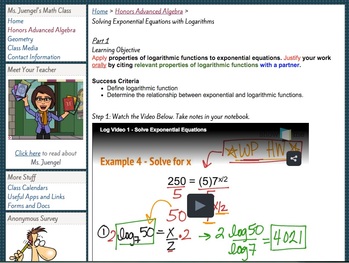|
As a part of my instructional practice this year, I have been working hard to get better at using student data to plan for reteaching and differentiation. Last year and the beginning of this year, I have used common formative assessments to analyze student misconceptions and plan strategies for reteaching content with other members of my professional learning community. This often included warm ups that reviewed older content or connecting new content to the older content, which seemed to work according to my assessment results (all averages have improved from last year's scores). While this effort has been helpful to students and allowed me to adjust instruction to meet their needs, I have been working hard to take this process even further. Phase 2 of this process included instructional days with assignments designed to allow students to work at their own pace. Students could complete the assignment as slowly or quickly as they needed. During this time, I would talk with the students that needed extra support and provide a mini-lesson or other instructional support to address their misconception. Again, this was working well, but I wanted my teaching practice to include more of my technological strength. This semester, I have been incorporating more technology tools as a means for providing students with differentiated assignments and supports. For example, last week I gave students tasks in three levels that allowed them to work through the content at their own pace. For students who struggled at level one, Khan Academy had built-in tutorial videos students could watch to get extra support. This helped me concentrate my efforts on tracking student progress and working one-on-one with students who needed support the most.  Screen shot of Phase 2 Activity on Class website. Screen shot of Phase 2 Activity on Class website. This brings me to my latest phase of this process. This week, students in my class did poorly as a whole on their quiz. Even after warning students of the many misconceptions and potential mathematical errors that can occur when solving equations with rational exponents, I saw every possible combination of mistakes. One of my colleagues had a similar result. It was clear that we needed to provide students with more practice. However, there were a handful of student in each section of my class who did incredibly well and would definitely get bored if they had stay working on the same material. I decided to start the intro to the next concept, using logarithmic functions to solve exponential equation (which requires an understanding of inverses). This gave me and students a break from the previous concept while giving me time to come up with a plan for moving forward (or going back). I created next steps for students in two phases. Phase one: review of equations with rational exponents and online exercises that can give student immediate feedback on their solutions. Students who did poorly on the quiz would have an opportunity to relearn the previous concepts and those continuously getting stuck can get one-on-one support. Phase two: applying logarithmic functions to exponential equations and exponential word problems. Students who do not need to go back to equations can continue with new material and stay engaged during class. Unlike prior activities, I marked the bottom of each student's quiz with a 1 or a 2, to indicate which phase they should start on for the day's activities. While it is impossible to know how any lesson will go on a given day, I'm feeling very confident about my activities for tomorrow. Between the planned activities and my implementation of Classcraft, I know we're going to have a lot of fun :) For more information on my start to Classcraft, see my post from last week.
1 Comment
 Today, I started creating student accounts for Classcraft. If you're not familiar with Classcraft, check out my previous post on why I'm excited about Classcraft. As a part of class activities for today and tomorrow, students are expected to complete three levels of individual activities, found at my class website here. If you go to my site, you see that I have a level one experience of completing practice problems on exponents through Khan Academy. This is a skill we have been working on extensively in my classroom, but students still seem to struggle. Making this the first activity allowed students to loop back and get the support they needed. For students ready to move on, I included two new video lessons that support the next ideas in our unit. Students had to complete notes and practice problems to move on to the next level. This sequence allowed me to differentiate for each student, while making time to make Classcraft accounts for the students who brought in permission forms. I decided that as students complete each activity they can earn their first 50 experience points for their new character. I decided to showcase the avatars and the experience points during class to encourage other students to get their permission slips in quickly - that way they can start playing the game too! I by no means consider myself and expert in using Classcraft at this point (not at all), but I do believe that this sequence of activities did a great job encouraging students to get permissions slips turned in. Below are some interesting observations about the process.
This is the very beginning of what I hope will be a long and fun journey into gamification. I am even more excited to see that Classcraft has provided goodies for participants of #edcampdenver. I will definitely be attending and think that anyone interested in meeting a wonderful group of educators should attend - February 6th at Grant Beacon Middle School. Maybe we can talk about Classcraft and find new ways to make the classroom fun for students and teachers! For more information on #edcampdenver and to register for the event go to their website. Hope to see you there!
Our school is currently going through some major changes. As a part of some committee work, I will have to miss time in my classroom. Assigning practice problems does not always work to best support students and there is increased difficulty when you have to miss multiple days. This can also be difficult when you have a week with a strange schedule. For example, last week we had the Pathways Fair on Monday, the Choice of Studies process on Tuesday, and we administered the WIDA ACCESS test on Wednesday. As a part of committee work, I was out all day for a training on Thursday. Simply leaving practice exercises was not going to be in the best interest of students - instructional support was necessary and many students were ready for new content. However, it is impossible to guarantee that your substitute has a strong understanding of your content area, especially in math. As a result, I created some instructional videos using the app, ShowMe. I set up my computer with the projector and instructed the substitute to play the video for each class. Below are the videos I left.
When I returned to my classroom the next day, students had mixed reactions to the video. Some of them liked the ability to take notes, while others were a little lost. While I had stated in the video that students should have the ability to pause the video, that doesn't mean it happened. Next time, I will designate individual students to run the video controls in order to ensure the videos have the best possible impact on student learning. Leaving videos for a sub will be an ongoing project this year and I will be sure to update my progress on my blog. That being said, I believe strongly that schools should make it easy for teachers to leave video sub plans and provide the necessary support for students. This would help both teachers and the guest teachers provide students with the supports they need to keep learning, even when their teacher is away.
|
AuthorMattea Garcia is a human-centered problem-solver dedicated to improving learning and technology experiences. This blog is dedicated to reflections on leadership, educational technology, instructional coaching, educational equity, and more. Archives
June 2022
Categories |

 RSS Feed
RSS Feed
